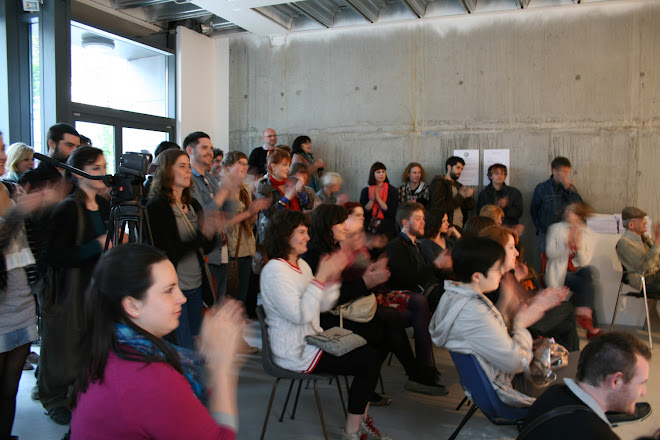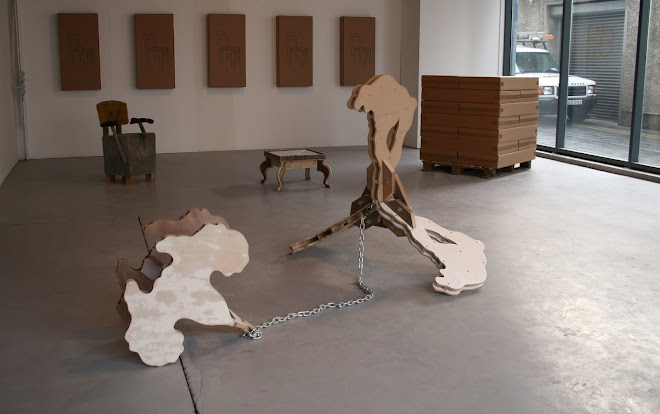The
Good Hatchery

A
talk by artists Carl Giffney & Ruth Lyons
The
Good Hatchery was founded in 2007 by five Sculpture graduates from
The National College of Art and Design. Graduating in Dublin during
the prosperous boom years, there was little chance of securing a
studio space for anything less then you’re first born. So the group
decided to focus on the finance aspect of art practice, or more to
the point focus on how far one could get without any finance. The
experiment to see if it could be done started with a search for a
suitable space. Using the internet, they placed an ad on free cycle,
looking for a suitable building to use as a studio. Eventually they
received a genuine response from a woman in a rural part of Co.
Offaly. They could have the building for free in exchange for them
renovating it.
Both
Carl and Ruth highlighted the importance of the internet in the
success of The Good Hatchery. Although in an isolated part of the
country, they still had the ability to stay connected with the art
world in the larger cities. Everything used to build and renovate The
Good Hatchery was sourced free and the work was done by themselves,
using the internet again, to teach them the necessary construction
skills. The pair mentioned the risk free element to the project.
Because no one had invested any money and there were no overheads, if
the project failed they would have only lost the time they put
in.
Although
initially five people were involved in the project, at the end of the
first year three decided to leave. Now with just Ruth and Carl left,
there was an opportunity to avail of the extra space left by the
others departure. This led them to experiment with a residency
program. Unsure of who would want to come to the middle of no where
for four weeks they sent out a call for proposals. The fruition of
this was they’re first residency ‘Sapphire Highway’. Three
artists, Sinead Breathnach Cashell, Ronan Coughlan and Patrick
Corcoran, were selected. The work produced engaged with the rural
landscape and community in which the Good Hatchery is situated. The
work exemplifies the freedom and spectrum of creative possibilities
which the Good Hatchery offers. Work ranging from Cashell’s
colourful and surreal inhabiting of ‘non spaces’ to Cocaran’s
abandoned DVD’s, left to haunt the abandoned Briquette factory that
is the subject of the film they hold. And Coughlin’s offer of a
free day of labour for anyone who wanted it, ultimately became a
humorous and futile effort to penetrate a closed rural
community.
After
building up an profile they began to be invited to curate
exhibitions, one such exhibition was ‘Celestial Salt’ in which
artists had to propose a piece of work that had previously be seen in
a fine art context, but re-appropriate it in a rural landscape with
no fine art infrastructure. The result was an impressive experiment
in re-appropriation and re -evaluation of fine art interpretation.
Raising questions about the fundamentals, such as why do artists
create and would they make work even if it would never actually be
seen. Isolated in rural landscapes, the art works are stripped back,
free from the confines and contexts of fine art institutions, allowed
to stand on their own. The absence of an audience transforms the
works from art objects into abandoned artefacts lost in a wild
expanse. This project and approach raises an interesting if not
amusing notion. Concerning the geographical isolation of these art
works, are they really more isolated then when they were shown in a
fine art context. Arguably, galleries are equally as inaccessible as
rural bog lands, if not physically, than psychologically, when we
truly consider the demographic who visit them.
While
it could have been seen as a risk, there is something tantalising
about the idea of randomly coming across these art works. And one can
only imagine the much debating among those who did and they’re, no
doubt, endless and amusing theories of what and where these objects
came from.
The
Good Hatchery’s success is a result of resourcefulness and hard
work. Both Ruth, Carl and the other founding members focus and
determination has turned the Good Hatchery into impressive and
enviable facility. It has also proven that contemporary art practice
can flourish outside major cities, especially Dublin. In what
sometimes can feel like a very centralised country, it is refreshing
to have a creative space supporting emerging artists, that is free
from the negative and often financial obstacles of more formal Fine
Art Institutions.


